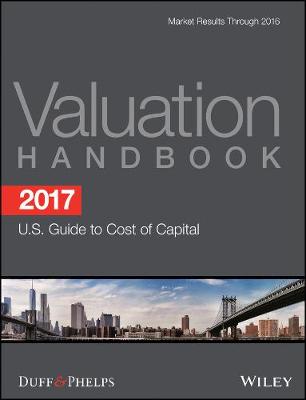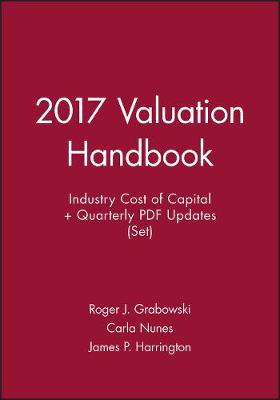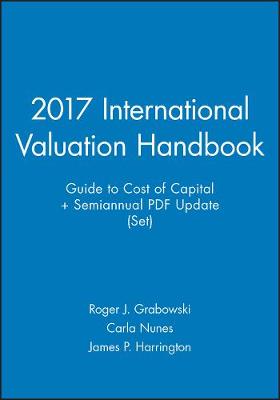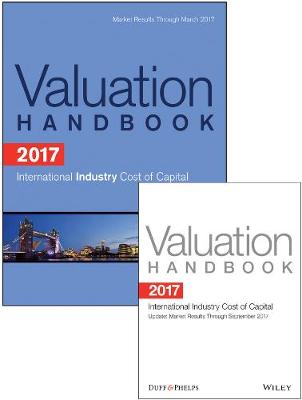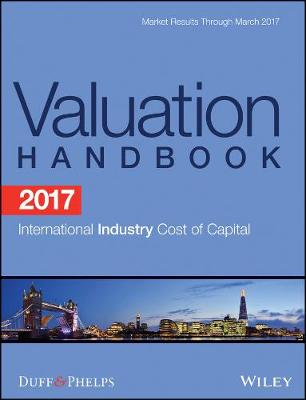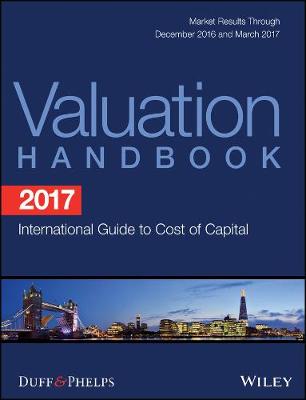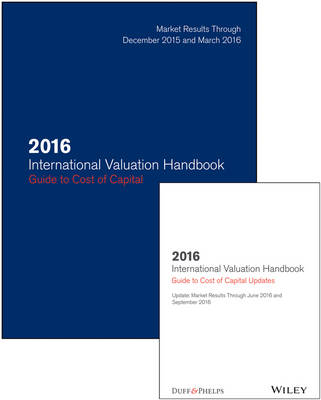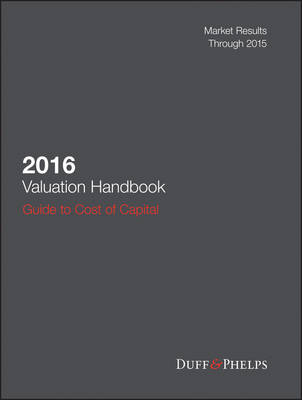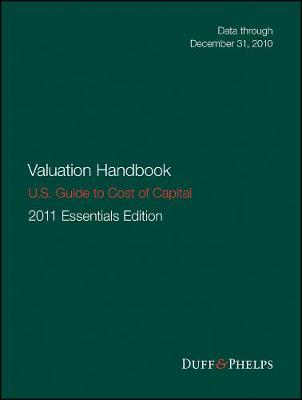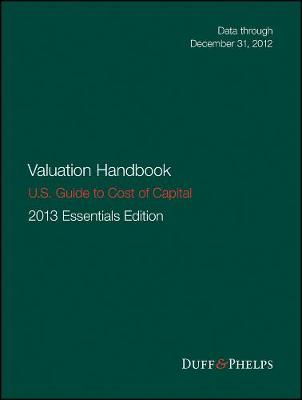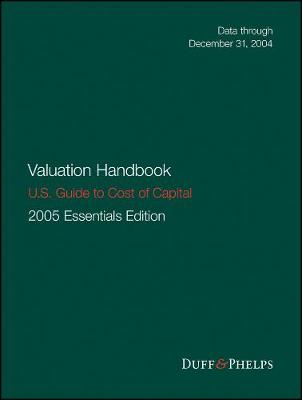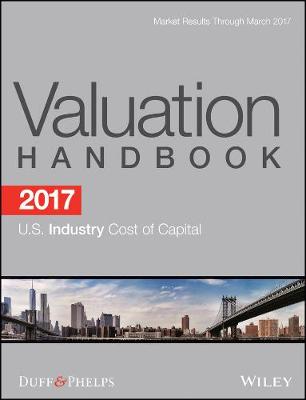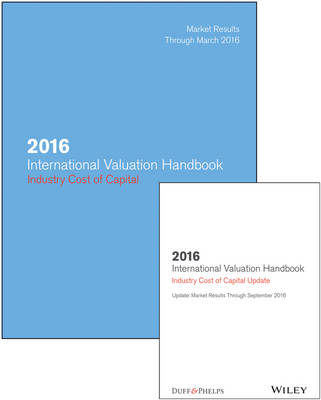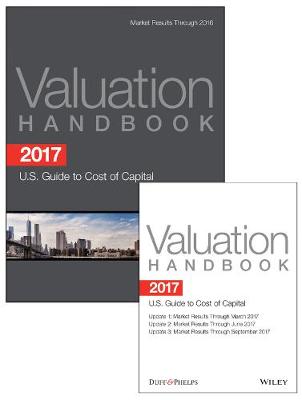Wiley Finance
1 primary work • 39 total works
2017 Valuation Handbook - U.S. Guide to Cost of Capital
by Roger J. Grabowski, Carla Nunes, and James P. Harrington
The New Industry Standard in Business Valuation Reference Materials
2017 Valuation Handbook - U.S. Guide to Cost of Capital provides the key annual valuation data previously published in (i) the now discontinued Morningstar/Ibbotson SBBI Valuation Yearbook (discontinued in 2013), and (ii) the Duff & Phelps Risk Premium Report Study (no longer published as a stand-alone publication).
The size premia data previously published in the SBBI Valuation Yearbook is referred to as the "CRSP Deciles Size Premia" exhibits in the new 2017 Valuation Handbook - U.S. Guide to Cost of Capital, while the size and risk premia data published in the Duff & Phelps Risk Premium Report Study has been published annually since 1996 and, like the former SBBI Valuation Yearbook, provides data and methodology that can be used to develop cost of equity capital estimates using (i) the build-up method and (ii) the capital asset pricing model (CAPM).
The 2017 Valuation Handbook - U.S. Guide to Cost of Capital includes data through December 31, 2016, and is intended to be used for 2017 valuation dates.
For more information about Duff & Phelps valuation data resources published by Wiley, please visit www.wiley.com/go/valuationhandbooks.
Also Available
- 2017 Valuation Handbook - U.S. Industry Cost of Capital
- 2017 Valuation Handbook - International Guide to Cost of Capital
- 2017 Valuation Handbook - International Industry Cost of Capital
- Key cost of capital inputs: The 2017 Valuation Handbook - U.S. Guide to Cost of Capital provides the key inputs needed for developing the cost of equity capital (i.e., "discount rate") for use in estimating the value of a subject business, business ownership interest, security, or intangible asset. Inputs provided include: equity risk premia, size premia, risk premia over the risk free rate, full-information industry betas, industry risk premia, and the risk-free rate.
- Discussion of topics that come up most when performing valuation analysis: The 2017 Valuation Handbook - U.S. Guide to Cost of Capital includes straightforward discussions about: (i) valuation theory, (ii) the differences between the various cost of capital estimation models (build-up, CAPM, Fama-French), (iii) understanding the basic building blocks of cost of equity capital (the risk-free rate, the equity risk premium, the size premium, beta, the industry risk premium, the company-specific risk premium), (iv) whether to "normalize" risk-free rates or not, (v) a detailed comparison of the CRSP Deciles Size Premia Study (the former SBBI Valuation Yearbook data) and the Risk Premium Report Study, and more.
- Easy-to-follow examples: The 2017 Valuation Handbook - U.S. Guide to Cost of Capital is packed with easy-to-understand examples for properly using the data to develop levered, unlevered, and even "high-financial-risk" cost of equity capital estimates using various build-up methods and CAPM.
2017 Valuation Handbook -- U.S. Industry Cost of Capital + Quarterly PDF Updates (Set)
by Roger J. Grabowski, Carla Nunes, and James P. Harrington
2017 International Valuation Handbook - Industry Cost of Capital + Semiannual PDF Update (Set)
by Roger J. Grabowski, Carla Nunes, and James P. Harrington
2017 Valuation Handbook - International Industry Cost of Capital
by Roger J. Grabowski
The 2017 Valuation Handbook - International Industry Cost of Capital offers the same type of rigorous industry-level analysis published in the U.S.-centric Valuation Handbook - U.S. Industry Cost of Capital. It provides industry-level cost of capital estimates (cost of equity, cost of debt, and weighted average cost of capital, or WACC), plus detailed industry-level statistics for sales, market capitalization, capital structure, various levered and unlevered beta estimates (e.g., ordinary-least squares (OLS) beta, sum beta, peer group beta, downside beta, etc.), valuation (trading) multiples, financial and profitability ratios, equity returns, aggregate forward-looking earnings-per-share (EPS) growth rates, and more.
For more information about Duff & Phelps valuation data published by Wiley, please visit www.wiley.com/go/valuationhandbooks.
Also Available
2017 Valuation Handbook - International Guide to Cost of Capital2017 Valuation Handbook - U.S. Guide to Cost of Capital2017 Valuation Handbook - U.S. Industry Cost of Capital Key Features
Four global economic regions: The 2017 Valuation Handbook - International Industry Cost of Capital includes industry-level analyses for four global economic regions: the "World," the European Union, the Eurozone, and the United Kingdom. Industries in the book are identified by their Global Industry Classification Standard (GICS) code (at the 2-, 4-, and 6-digit code level).Three currencies: Each of the four global region's industry analyses are presented in three currencies: the Euro, the British pound, and the U.S. dollar.
2017 Valuation Handbook
by Roger J. Grabowski, Carla Nunes, and James P. Harrington
EVERYTHING YOU NEED FOR ACCURATE INTERNATIONAL COST OF CAPITAL ESTIMATIONS IN A SINGLE VOLUME
The 2017 Valuation Handbook International Guide to Cost of Capital is part of the U.S. and international series of valuation resources authored by Duff & Phelps and published by John Wiley & Sons. This annually updated reference provides business valuation and finance professionals with the critical data they need to assess risk and develop cost of capital estimates on a global scale.
Gauging the risks of an international investment is one of the trickiest aspects of finance. This comprehensive guidebook provides you with usable international data and methodology, and the ability to:
- Turn to a definitive resource of world-class data and guidance to gain a distinct competitive advantage in real-world situations.
- Access costly and difficult-to-obtain international data, assembled into easy-to-use cost of capital inputs at an accessible price point.
- Quickly grasp how concepts and methodologies translate into actual practice when they are brought to life in exemplifying cases.
Accurate. Reliable. Trusted. The 2017 Valuation Handbook International Guide to Cost of Capital gives you the upper hand the moment you open it.
Other volumes in the annual series include:
- 2017 Valuation Handbook International Industry Cost of Capital
- 2017 Valuation Handbook U.S. Guide to Cost of Capital
- 2017 Valuation Handbook U.S. Industry Cost of Capital
2016 Valuation Handbook Guide to Cost of Capital Book + Updates
by Roger J. Grabowski, James P. Harrington, and Carla Nunes
2016 International Valuation Handbook – Guide to Cost of Capital + Semiannual PDF Update (Set)
by Roger J. Grabowski, James P. Harrington, and Carla Nunes
*Relative Volatility (RV) factors for up to 69 countries: The 2016 International Valuation Handbook - Guide to Cost of Capital provides country-level relative volatility factors for up to 69 countries from the perspective of investors in the U.S. and Germany. Relative volatility factors are estimated using the Relative Standard Deviation Model. *Equity Risk Premia (ERPs) for 18 countries based in USD and "local" currency: The 2016 International Valuation Handbook - Guide to Cost of Capital provides long-horizon and short-horizon ERP data in USD and "local" currencies. Additional ERP resourcse include Pablo Fernandez' survey of ERPs for a variety of countries. *Dependent on the estimation model being employed and data availability. Some models do not include estimates for all countries.
2016 Valuation Handbook
by Roger J. Grabowski, James P. Harrington, and Carla Nunes
2016 Valuation Handbook – Guide to Cost of Capital provides the key annual valuation data previously published in (i) the now discontinued Morningstar/Ibbotson
SBBI Valuation Yearbook (discontinued in 2013), and (ii) the Duff & Phelps
Risk Premium Report (no longer published as a stand–alone publication).
The size premia data previously published in the
SBBI Valuation Yearbook is referred to as the "CRSP Deciles Size Premia" exhibits in the new
2016 Valuation Handbook – Guide to Cost of Capital, while the size and risk premia data published in the Duff & Phelps
Risk Premium Report has been published annually since 1996 and, like the former
SBBI Valuation Yearbook, provides data and methodology that can be used to develop cost of equity capital estimates using (i) the build–up method and (ii) the capital asset pricing model (CAPM).
The
2016 Valuation Handbook includes data through December 31, 2015, and is intended to be used for 2016 valuation dates.
For more information about Duff & Phelps valuation data resources published by Wiley, please visit www.wiley.com/go/valuationhandbooks.
Also Available
- 2016 Valuation Handbook – Industry Cost of Capital
- 2016 International Valuation Handbook – Guide to Cost of Capital
- 2016 International Valuation Handbook – Industry Cost of Capital
Key Features
- Key cost of capital outputs: The 2016 Valuation Handbook provides the key inputs needed for developing the cost of equity capital (i.e., "discount rate") for use in estimating the value of a subject business, business ownership interest, security, or intangible asset. Inputs provided include: equity risk premia, size premia, risk premia over the risk free rate, full–information industry betas, industry risk premia, and risk–free yields.
- Discussion of topics that come up most when performing valuation analysis: The 2016 Valuation Handbook includes straightforward discussions about: (i) valuation theory, (ii) the differences between the various cost of capital estimation models (build–up, CAPM, Fama–French), (iii) understanding the basic building blocks of cost of equity capital (the risk–free rate, the equity risk premium, the size premium, beta, the industry risk premium, the company–specific risk premium), (iv) whether to "normalize" risk–free rates or not, (v) a detailed comparison of the CRSP Deciles Size Premia Study (this is the former SBBI Valuation Yearbook data) and the Risk Premium Report Study, and more.
- Easy–to–follow examples: The 2016 Valuation Handbook is packed with easy–to–understand examples for properly using the data to develop levered, unlevered, and even "high–financial–risk" cost of equity capital using various build–up methods and the CAPM.
Valuation Handbook - U.S. Guide to Cost of Capital
by Roger J. Grabowski, James P. Harrington, and Carla Nunes
Valuation Handbook - U.S. Guide to Cost of Capital
by Roger J. Grabowski, James P. Harrington, and Carla Nunes
Valuation Handbook - U.S. Guide to Cost of Capital
by Roger J. Grabowski, Carla Nunes, and James P. Harrington
2016 International Valuation Handbook Guide to Cost of Capital Book + Updates
by Roger J. Grabowski, James P. Harrington, Carla Nunes, and Duff & Phelps Corp.
2016 Valuation Handbook Industry Cost of Capital Book + Updates
by Roger J. Grabowski, James P. Harrington, and Carla Nunes
The book includes cost of capital estimates (i.e., equity capital, debt capital, and WACC) for over 200 U.S. industries and size groupings (i.e., large-, mid-, low-, and microcapitalization companies), plus a host of detailed statistics that can be used for benchmarking purposes. It contains data which the valuation analyst will find useful in benchmarking, augmenting, and supporting his or her own custom analysis of the industry in which a subject business, business ownership interest, security, or intangible asset resides.
2017 Valuation Handbook - U.S. Industry Cost of Capital
by Roger J. Grabowski, Carla Nunes, James P. Harrington, and Duff & Phelps
The most recent cost of capital data for approximately 180 U.S. industries, identified by Standard Industrial Classification (SIC) code
The 2017 Valuation Handbook – U.S. Industry Cost of Capital provides valuation professionals with the same type of rigorous industry-level analysis previously published in the green-cover Morningstar/Ibbotson Cost of Capital Yearbook (now discontinued).
The 2017 Valuation Handbook – U.S. Industry Cost of Capital provides up to eight cost of equity capital and weighted average cost of capital (WACC) estimates for each of the U.S. industries covered in the book, plus capital structure, valuation (trading) multiples, sales, market capitalization, several levered and unlevered beta estimates (e.g., ordinary-least squares (OLS) beta, sum beta, downside beta, etc.), financial and profitability ratios, equity returns, aggregate forward-looking earnings-per-share (EPS) growth rates, and more.
The 2017 Valuation Handbook – U.S. Industry Cost of Capital includes data through March 31, 2017, and is intended to be used for 2017 valuation dates.
For more information about Duff & Phelps valuation data resources published by Wiley, please visit www.wiley.com/go/valuationhandbooks.
Also Available
- 2017 Valuation Handbook – U.S. Guide to Cost of Capital
- 2017 Valuation Handbook – International Guide to Cost of Capital
- 2017 Valuation Handbook - International Industry Cost of Capital
- Access cost of capital estimates and betas for approximately 180 U.S. industries
- Reference industry-level valuation multiples, growth rates, sales, capital structure, profitability ratios, plus statistics that enable the user to gauge the impact of "debt-like" off-balance-sheet items on the capital structure of the subject industry
- Use the information in this book to (i) benchmark, (ii) augment, and (iii) provide additional support for your own custom analyses of the industry in which a subject business, business ownership interest, security, or intangible asset resides
2016 International Valuation Handbook - Industry Cost of Capital + Semiannual PDF Update (Set)
by Roger J. Grabowski, James P. Harrington, Duff & Phelps, and Carla Nunes
2017 Valuation Handbook – U.S. Guide to Cost of Capital provides the key annual valuation data previously published in (i) the now discontinued Morningstar/Ibbotson SBBI Valuation Yearbook (discontinued in 2013), and (ii) the Duff & Phelps Risk Premium Report Study (no longer published as a stand-alone publication).
The size premia data previously published in the SBBI Valuation Yearbook is referred to as the "CRSP Deciles Size Premia" exhibits in the new 2017 Valuation Handbook – U.S. Guide to Cost of Capital, while the size and risk premia data published in the Duff & Phelps Risk Premium Report Study has been published annually since 1996 and, like the former SBBI Valuation Yearbook, provides data and methodology that can be used to develop cost of equity capital estimates using (i) the build-up method and (ii) the capital asset pricing model (CAPM).
The 2017 Valuation Handbook – U.S. Guide to Cost of Capital includes data through December 31, 2016, and is intended to be used for 2017 valuation dates.
The accompanying PDF Updates refresh industry risk premia and betas from the 2017 Valuation Handbook – U.S. Guide to Cost of Capital on a quarterly basis with data through March, June, and September 2017 for a full year of coverage.
For more information about Duff & Phelps valuation data resources published by Wiley, please visit www.wiley.com/go/valuationhandbooks.
Also Available
2017 Valuation Handbook – Industry Cost of Capital + Quarterly PDF Updates
2017 Valuation Handbook – International Guide to Cost of Capital + Semiannual PDF Update
2017 Valuation Handbook – International Industry Cost of Capital + Semiannual PDF Update
Key Features
Key cost of capital inputs: The 2017 Valuation Handbook – U.S. Guide to Cost of Capital provides the key inputs needed for developing the cost of equity capital (i.e., "discount rate") for use in estimating the value of a subject business, business ownership interest, security, or intangible asset. Inputs provided include: equity risk premia, size premia, risk premia over the risk-free rate, full-information industry betas, industry risk premia, and the risk-free rate.
Discussion of topics that come up most when performing valuation analysis: The 2017 Valuation Handbook – U.S. Guide to Cost of Capital includes straightforward discussions about: (i) valuation theory, (ii) the differences between the various cost of capital estimation models (build-up, CAPM, Fama-French), (iii) understanding the basic building blocks of cost of equity capital (the risk-free rate, the equity risk premium, the size premium, beta, the industry risk premium, the company-specific risk premium), (iv) whether to "normalize" risk-free rates or not), (v) a detailed comparison of the CRSP Deciles Size Premia Study (the former SBBI Valuation Yearbook data) and the Risk Premium Report Study, and more.
Easy-to-follow examples: The 2017 Valuation Handbook – U.S. Guide to Cost of Capital is packed with easy-to-understand examples for properly using the data to develop levered, unlevered, and even "high-financial-risk" cost of equity capital estimates using various build-up methods and CAPM.
The cost of illiquidity is a critical element in investing and trading in capital markets, and it involves a number of controversial issues. This book addresses these issues and provides practical knowledge for finance professionals seeking a more comprehensive assessment of a company's value. * Quantify illiquidity as part of a business valuation * Address illiquidity as a major factor is risk assessment * Estimate the impact of illiquidity on stock value * Apply illiquidity issues to markets around the globe Illiquidity is a significantly greater factor in stock value and business and asset valuations than previously thought, and its role in contemporary Wall Street and banking issues makes it an area of critical concern. Cost of Illiquidity is an invaluable resource with timely solutions for any finance professional.
